Connecticut native Ron Wotus was a 16th-round draft pick by the Pirates in 1979  after he finished high school. He does not feel that being from New England limited his professional prospects, as is sometimes the case because players in the Northeast often play far fewer games than their counterparts in the South and West because of weather limitations.
after he finished high school. He does not feel that being from New England limited his professional prospects, as is sometimes the case because players in the Northeast often play far fewer games than their counterparts in the South and West because of weather limitations.
“I felt like I got enough time in, with my regular schedule plus American Legion ball,” he said. He was primarily a shortstop, but also played second base.
He hit .277 in 48 games in Rookie League and A-ball in 1979, and .228 in 45 games in A-ball in 1980. A surprising development in early 1981 made him think his career might be over, though.
Spring Training Surprise His name was not on the roster of any Pirates farm club as teams were allocated during spring training. He feared he was about to be told to report to a location where he would be released and given a one-way ticket back home.
“As it turned out, a co-op team was put together, with players from five different organizations, and I went there,” he said. He played 134 games for Hagerstown (MD) that season.
In 1982 he split the season between AA and AAA, hitting .296 with 11 HR and 62 RBI. He hit .301 with 10 home runs and 62 RBI at AAA Hawaii in 1983, earning him his first big-league callup to the Pirates in September.
“The Pirates were in a pennant race then, so I didn’t figure to play much,” he said. He made his major-league debut September 3, and he got into five games (3 AB) at shortstop and second base.
“In 1984, I bounced back-and-forth between AAA and the big leagues,” he said. He hit .218 in 27 games with the Pirates, and .254 in 61 games with Hawaii.
But a larger problem was looming – one that affected Wotus for the rest of his playing career.
Dealing With Injury “I had an injured labrum, and it just wouldn’t heal,” Wotus said. “I couldn’t make the throw from short to first.” He was limited to 37 games in AA as he tried to work with and play through the injury. And even though he hit .315 in AAA in 1986, the Pirates released him.
He then spent three more seasons in AAA – one with the Royals organization and two with the Giants – before his playing career was over.
“The arm never really recovered.” — Ron Wotus, on his labrum injury
“I tried playing first base, outfield — all of it,” he said. “But my role in the big leagues would have been as a utility player. And in the big leagues, that means you have to be able to play short and make the throw from the hole. The arm never really recovered, so I was done as a player.”
Wotus had non-guaranteed job offers to play more AAA baseball after 1989, but he turned them down. “Maybe it would have been different if they had the surgical techniques they had today,” he said.
Besides, another opportunity presented itself: the Giants offered him a minor-league coaching job.
Coaching in the Minors “I had gotten married, I was getting older, and the playing offers were not for the big leagues,” he said. “I was also concerned about losing my health insurance. So I took the Giants job.”
After a season as a coach, Wotus was promoted to manage  the Giants’ Class A affiliate in San Jose. He promptly led that team to a 92-44 record, and he was named California League Manager of the Year.
the Giants’ Class A affiliate in San Jose. He promptly led that team to a 92-44 record, and he was named California League Manager of the Year.
Wotus managed one more season in San Jose, then spent three seasons managing the AA Shreveport Captains. He was promoted again in 1997 to AAA, and managed the Phoenix Firebirds for three seasons. He was Pacific Coast League Manager of the Year in 1997 when the Firebirds closed the season on a 41-10 run to finish 88-55.
Back to the Big Leagues Another promotion came in 1998,  when Wotus was added to the big-league coaching staff as third-base and infield coach. In 1999 he was named bench coach under manager Dusty Baker, beginning an 18-season run in that position.
when Wotus was added to the big-league coaching staff as third-base and infield coach. In 1999 he was named bench coach under manager Dusty Baker, beginning an 18-season run in that position.
Wotus admitted that he did “manage” the game as a bench coach, so that he had plenty of options ready to suggest to the manager, and to answer other questions in a support role.
“Yes, I certainly did [manage the games mentally] during those years. And I also had a lot of other responsibilities, especially with the infield defense,” he said.
Big League Manager? Wotus’ work and track record did not go unnoticed; in 2000 he interviewed for the Pirates’ managerial vacancy, and he also talked to the Dodgers (2005), Mariners (2013), Rays (2014) and Nationals (2015) about their job openings.
But it was “close, but no cigar” each time. He has yet to become a big-league manager.
Why?
“In 2000 with the Pirates, I think maybe I just wasn’t ready,” Wotus told me. “Other times, I thought I was pretty close. But many times, it seems like they have an idea of who they want from the beginning. If you don’t just blow them away in the interview, you won’t overcome that.”
“Other times, you just may not be the right fit,” he said. “It’s hard to say.”
In 2016, I had a chance to ask Giants executive Brian Sabean about Wotus, and why he thought Ron had not landed a big-league manager’s job.
Sabean frowned and shook his head.
“I just don’t understand it. He certainly deserves a chance” –Giants executive Brian Sabean, about Ron Wotus’ big-league managerial aspirations
“We have tried to help him [land a job] any way we could when he interviewed,” he said. “It has been frustrating. We love having him here, but he should get a shot.”
With Wotus’ long run as bench coach under several Giants managers, I asked him if he ever was told, or he suspected, that he was next in line after current manager Bruce Bochy. Was Wotus the manager-in-waiting in San Francisco?
“No, I’ve never been told that. I don’t think you would ever be told something like that,” he said.
Back to Third Base In 2018, the Giants shook up their coaching staff after the team had a poor season. Among the changes was Wotus’ return to coaching third base, and Hensley Meulens was named bench coach.
Wasn’t that a demotion, or at least disappointing?
“No, actually after that long, I was up for something new – a different challenge. We had some problems at third base in recent seasons, and so I was happy to go back.
“Besides,” he says, I still have plenty to do, working with the infielders.”
Indeed, Wotus has drawn favorable reviews for his judgment about sending or holding runners – a sore spot in recent seasons. He’s more aggressive than his immediate predecessors.
Infield Coach One thing that has not changed is the praise Wotus has received for his work positioning the Giants’ infielders, and his one-on-one fielding instruction with them.
I asked Ron if his individual work was about refining existing skills, moreso than actual instruction.
“There is more teaching done in the big leagues than there used to be,” he said. “But many times it’s just reminding guys about little things about receiving the ball, or footwork around the bag.”
Is it different when an infielder comes from outside the organization, such as Alen Hanson in 2018?
“Yes, because sometimes we see players who have not had instructors who paid as much attention to the details of infield play,” Wotus said.
Are there common problems he sees coaching infielders at the big-league level?
“Almost everyone tries to be too quick fielding and throwing the ball,” he said. “I try to get them to slow down and make a solid play.
“That’s the beauty of a guy like [Brandon] Crawford – he doesn’t go for the flashy play, but he makes the routine play and puts the throw in a good position.”
Can you teach a big-league player to have “soft” hands, or improve their hands?
“You can work with them on how they receive the ball and things like that, but the biggest part of having good hands is a natural thing,” he said. “And many times, I find that the hands are not so much the issue as the feet.
“Bad feet can lead to bad hands.” — Ron Wotus, on infield play
“If we can improve their footwork, their hands will get better too. Otherwise they are reaching for the ball, and everything seems like it’s a bad hop,” he explained.
Getting Right Are players more receptive to coaching these days?
“The key is, you better be ‘right’ with a player when you coach them,” he said, meaning that any advice he gives about infield play needs to be solid, and something the player can absorb and believe in.
The Giants do their share of infield shifts and positioning, and Wotus told me that the Giants have an analytics person on board now to give him additional information about hitters’ tendencies.
It’s more than just studying spray charts, though, and the shifts are not etched in stone.
“It’s flexible, depending on who is pitching and how their command is,” he said. It’s a different animal for a sinker-slider pitcher who induces many ground balls, or a pitcher such as Jeff Samardzija or Dereck Rodriguez, who tend to yield more fly balls.
“But I also want the players to trust their instincts on a given day,” he said. He wants them to have a “feel” for the game and how the pitcher is doing. Is he hitting his spots? How is his velocity? And how are the hitters reacting?
What’s Next? So Ron Wotus is a busy guy. And he loves his work. He’s not unhappy with his current job.
But has the managerial ship sailed for Ron Wotus? Many teams look to hire bench coaches from other teams as big-league managers.
“No, I don’t think so,” Wotus said. “I am pretty visible at third base.”
Still …
“It will be interesting to see what happens at the end of the season. And I am in a different place in life than I was before,” he said.
“And being a part of four World Series teams, with three championships, should count for something too.”
